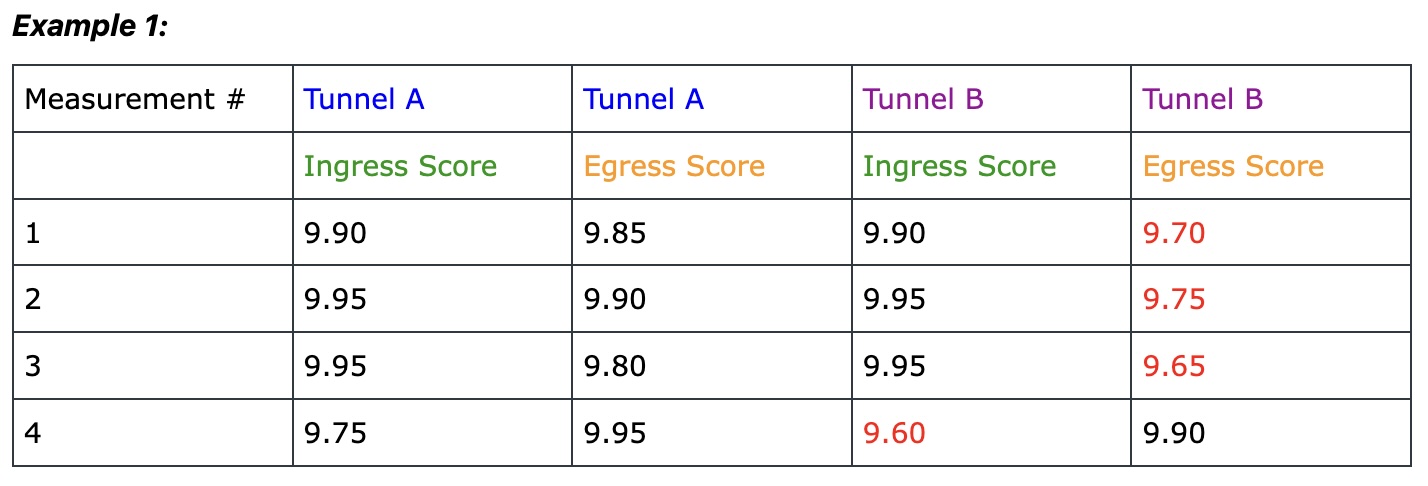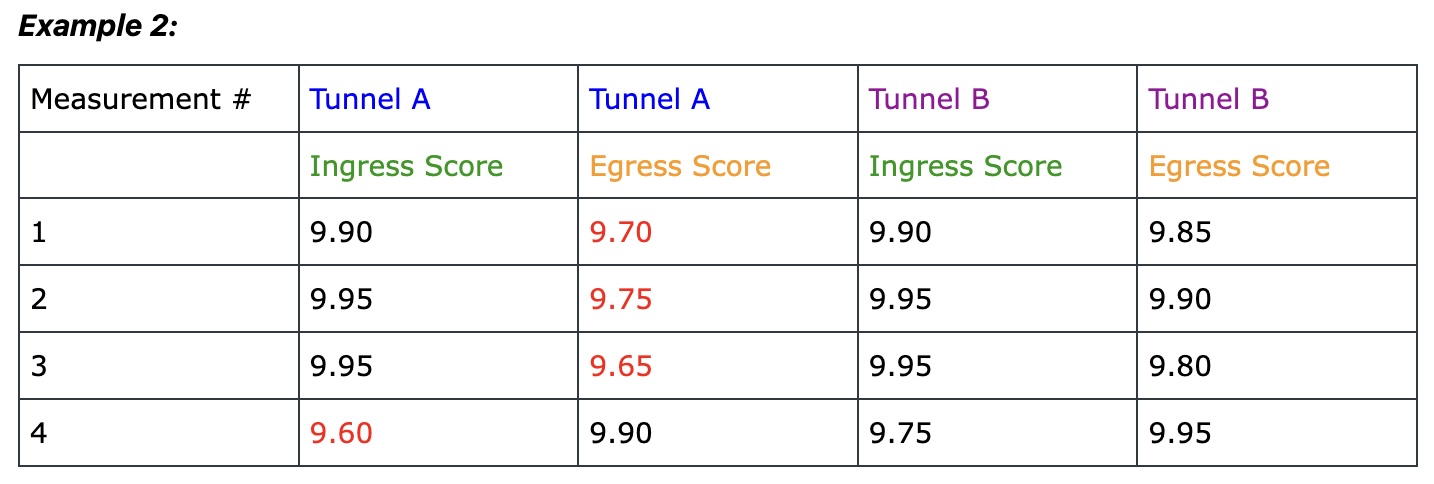Overview: How is Tunnel Selection Performed?
Graphiant has in place redundant tunnels from each WAN interface from the Graphiant Edge along the path to the Graphiant Core, to provide the best data transmission possible.
The tunnels are monitored continually, and periodic computations of the Graphiant Quality of Experience (G-QoE) scores that measure loss, latency, and jitter are performed for performance comparison between the two tunnels.
Depending on the resulting scores, the best path tunnel is selected to carry the traffic to and from the Graphiant Core.
Configuration of Tunnels Between the Graphiant Edge and the Core
Two tunnels are established from each WAN interface to the Graphiant Core, using two different Internet Service Provider (ISP) circuits, to two different Cores in the same PoP.

This redundancy guarantees diversity of the cores, as well as the ISPs and the tunnels.
Tunnel Selection Process
Terminology
The terminology for the tunnel pair selection is as follows:
Active: The tunnel currently being used to carry traffic.
Standby: The tunnel not currently in use but still included in the calculations.
Threshold: The G-QoE score that must be surpassed to trigger a tunnel switchover.
How Are Active Tunnels Initially Determined?
Initially, the Active tunnel is selected by:
Whichever tunnel comes up first when the pair are originally configured.
If activated simultaneously, whichever tunnel has better G-QoE score from the beginning.
Continual Tunnel Selection Process
Graphiant continually monitors and periodically compares the G-QoE (Graphiant Quality of Experience) scores across the two tunnels on each WAN interface.
The tunnels may switch roles based on the computed G-QoE score as to whether they are Active v/s Standby. This encompasses both forwarding and receiving traffic.
Note:
Since both tunnels were previously established, there is no significant impact to data transmission with regards to packet loss, latency, etc. when switching a tunnel from Standby to Active.
Computation to Determine the Active Tunnel
Computation of the G-QoE scores for ingress and egress on both tunnels are done every 15 seconds, using the transmission measurements over that interval.
A rolling comparison of every last four G-QoE measurements for each tunnel are compared between them.
The tunnel with the lowest score in either direction is chosen as the standby tunnel.
Note:
A threshold of 0.11 G-QoE is in place, so that the delta of the G-QoE scores needs to surpass it consistently in all four measurements in order to switch the Standby tunnel to Active.
If the difference is within the threshold, it is ignored.
If after the four consecutive G-QoE measurements the Active tunnel is performing better than the Standby tunnel, no action is taken and the Active tunnel remains Active.
If after the four consecutive G-QoE measurements the Standby tunnel is performing better than the Active tunnel, and all four scores result in a difference greater than the threshold, it is promoted to Active for both ingress and egress traffic.
Note:
The tunnel with the lowest score in either direction is chosen as the Standby tunnel for both ingress and egress traffic.
Tunnel Selection Examples
Consider the following examples, with Tunnel A being the current Active tunnel:

In the above table, Tunnel B has the lowest G-QoE score (noted in red) in all four measurements.
Therefore, no action will be taken and Tunnel A remains Active.

In the above table, Tunnel A has the lowest G-QoE score (noted in red) in all four measurements.
The differences between the low scores for Tunnel A v/s the scores for Tunnel B are greater than the Threshold difference of 0.11 G-QoE.
Therefore, Tunnel B will become the Active tunnel, and Tunnel A will switch to the Standby tunnel.

In the above table, Tunnel B has the lowest G-QoE score (noted in red) in the first three measurements, all surpassing the threshold of 0.11.
Tunnel A has the lowest G-QoE score (noted in red) in the fourth measurement.
Since there were not four consecutive measurements with the same tunnel having the lowest score, no action will be taken and Tunnel A remains Active.
The calculations will start over and will trigger a switchover only if four consecutive scores from the Standby tunnel meet the requirements.

In the above table, Tunnel A has the lowest G-QoE score (noted in red) in all four measurements.
However, the differences between the low scores for Tunnel A v/s the scores for Tunnel B are not all greater than the Threshold difference of 0.11 G-QoE; the fourth score has Tunnel A at 9.70, while Tunnel B is 9.75, yielding a difference of only 0.05 G-QoE.
Since there were not four consecutive measurements where Tunnel A had a lower score than Tunnel B and surpassed the threshold, no action will be taken and Tunnel A remains Active.
The calculations will start over and will trigger a switchover only if four consecutive scores from the Standby tunnel meet the requirements.
Damping Methods
Damping methods promote stability and prevent unnecessary flapping / switching too frequently between the two tunnels.
Graphiant utilizes the following damping methods:
Timer of 1 minute for four calculations to be done: By requiring four measurements to be taken and all four to result in the same tunnel scoring lower to switchover to Active, this ensures a minimum of one minute between switchovers.
A threshold to be met: By requiring the surpassing of a threshold, small differences that will naturally occur between the tunnels will not result in unnecessary switching between Active/Standby.